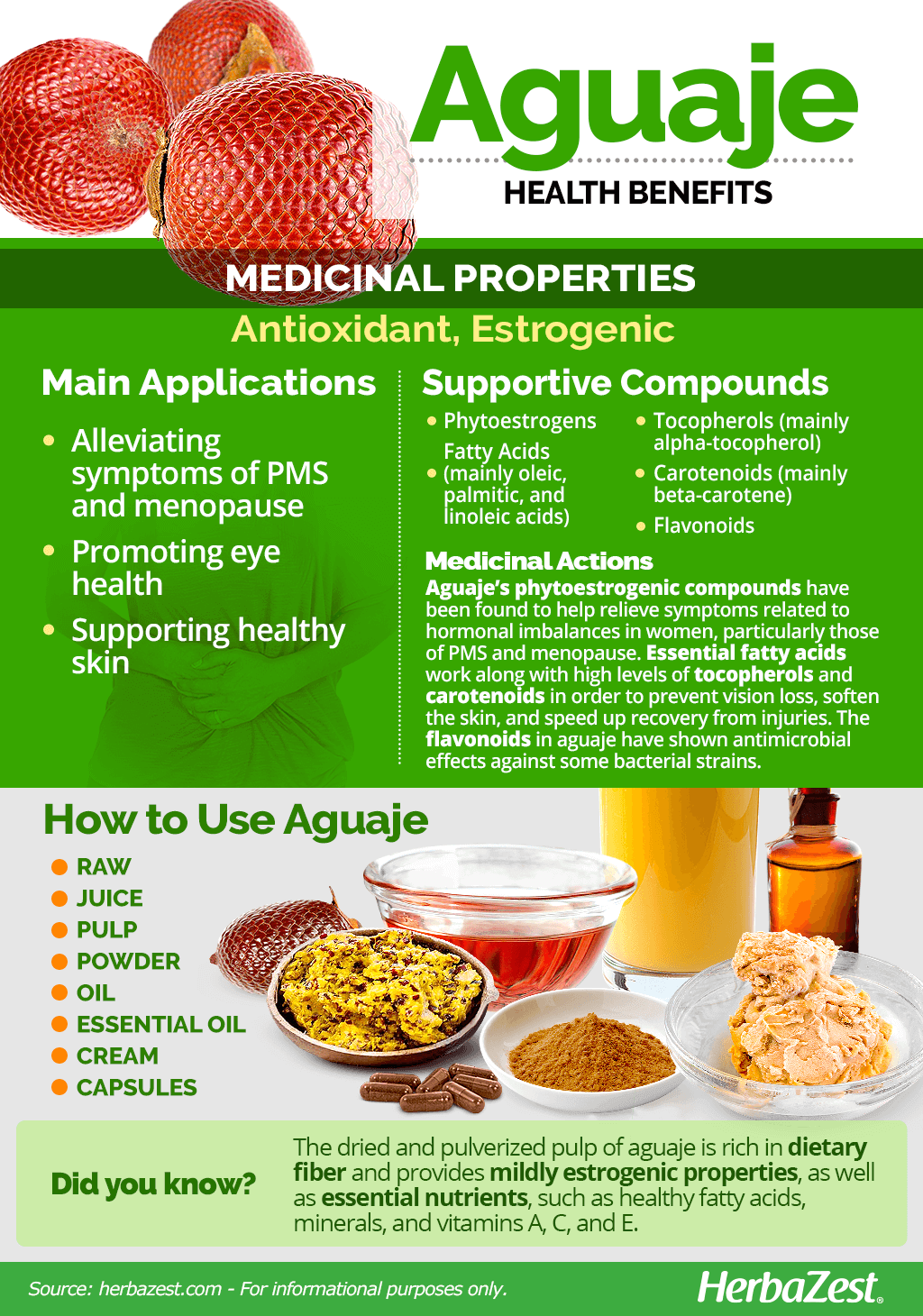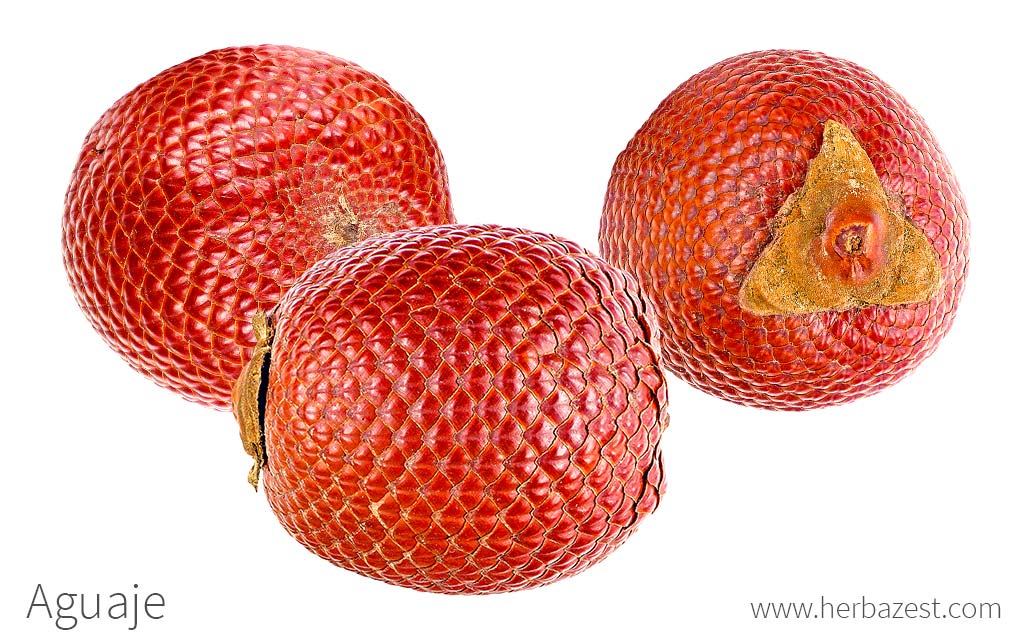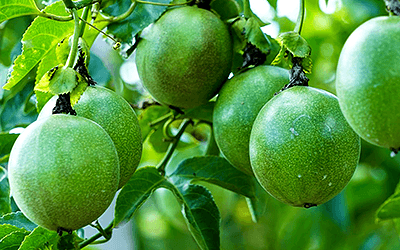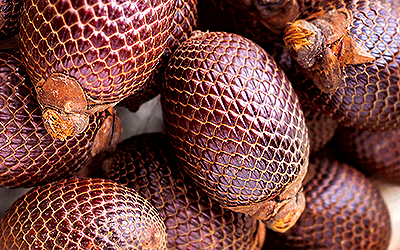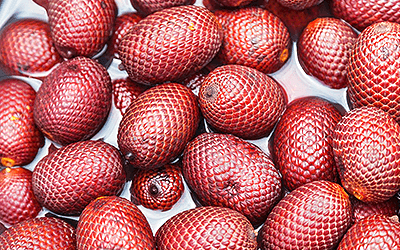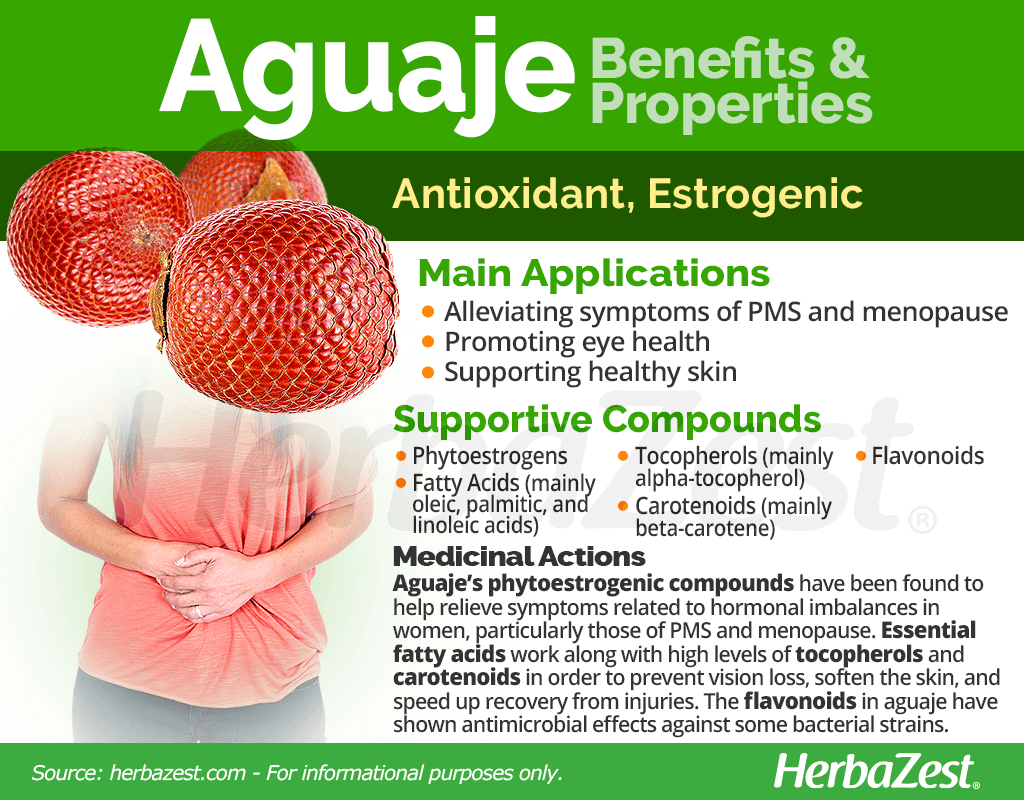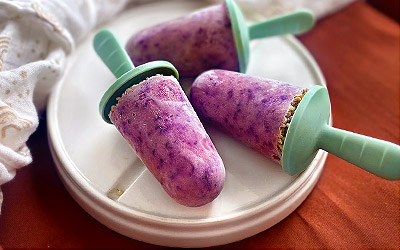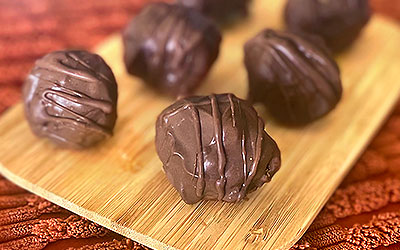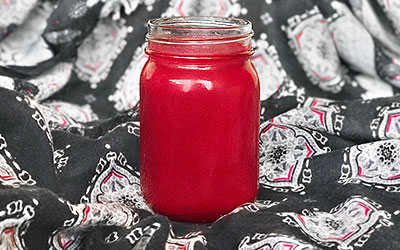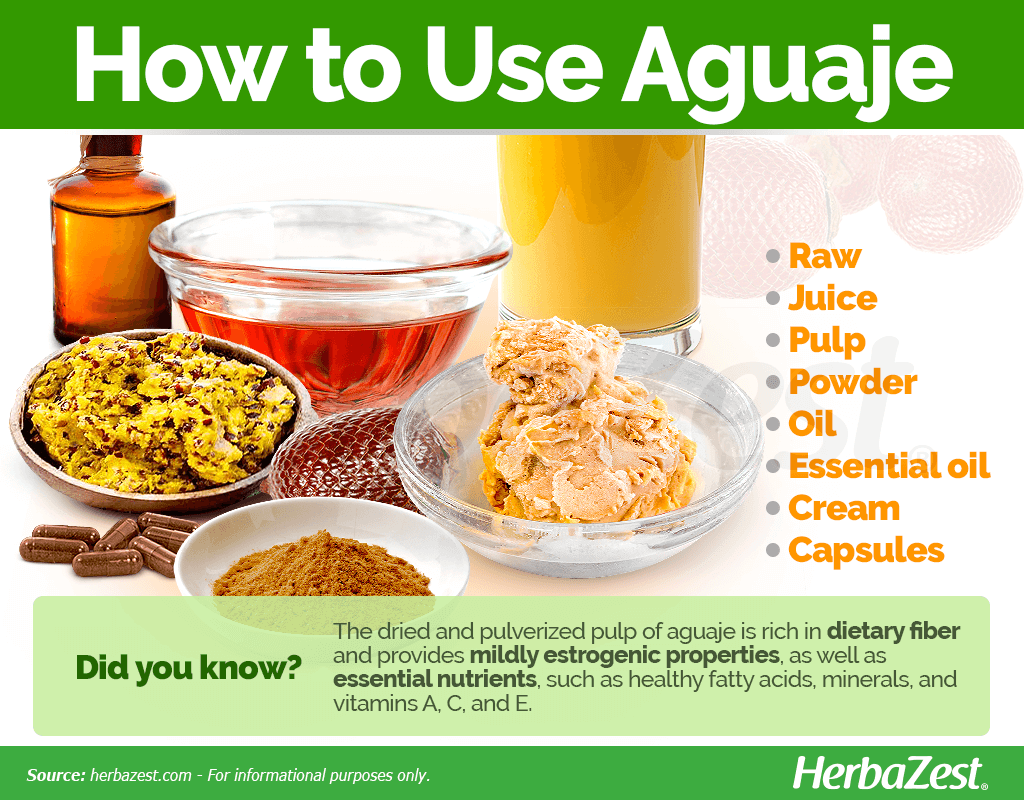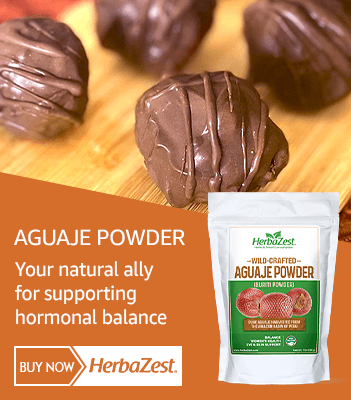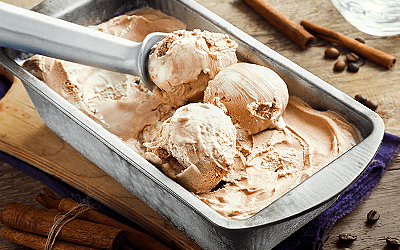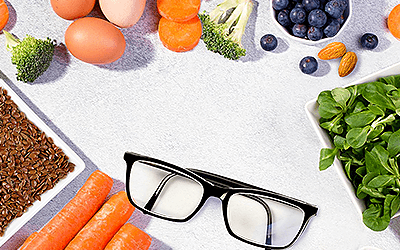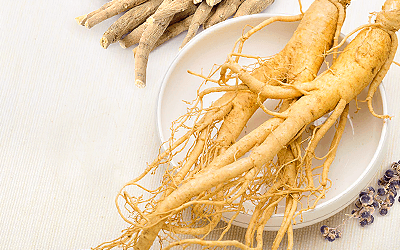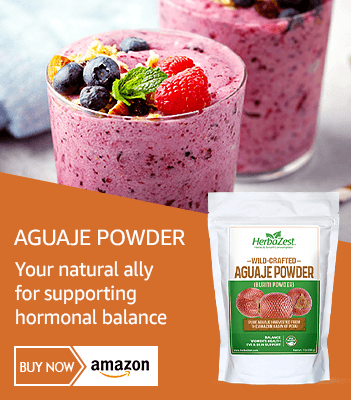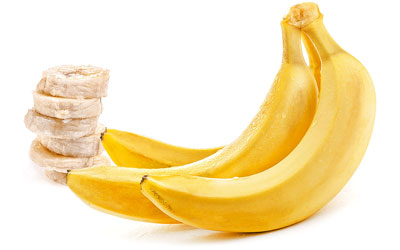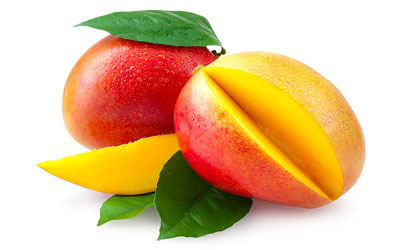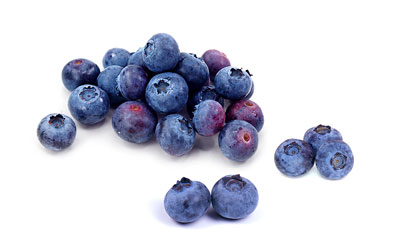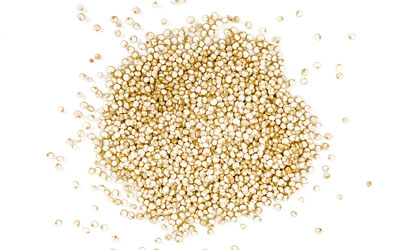Although the aguaje has been a staple of the Amazonian people's diet for centuries, and it is still being popularly used for both nourishment and healing purposes, it wasn't until the early years of the 21th century that the fruit of the moriche palm (Mauritia flexuosa) made its way to international markets and caught the attention of the scientific community. Keep reading to learn all about aguaje benefits, nutritional value, ways of consumption and more.
Aguaje Medicinal Properties
Health Benefits of Aguaje
While scientific research on aguaje is still insufficient, preliminary studies on the traditional uses of the moriche palm fruit suggest that it can help with the following:
Alleviating symptoms of PMS and menopause. Rich in phytoestrogens, aguaje can relieve menstrual discomforts as well as symptoms of estrogen deficiency during menopause.1
Promoting eye health. Given its astounding amounts of pro-vitamin A compounds, the buriti oil helps prevent xerophthalmia, which is the progressive loss of vision due to vitamin A deficiency.
Supporting healthy skin. High levels of antioxidant compounds in aguaje fruit support hair, nails, and skin health, also shielding the human body from UV light.
Additionally, studies have focused in other potential aguaje benefits, such as lowering cholesterol levels and treating bacterial infections. A study has also shown that aguaje may play a role in heart disease prevention thanks to its antiplatelet and antithrombotic properties.2
BURITI FRUIT OIL HAS BEEN TRADITIONALLY USED FOR NATURALLY SOFTENING AND HYDRATING THE SKIN, AS WELL AS FOR SPEEDING UP WOUND HEALING.
How It Works
The main bioactive compounds in aguaje, or buriti fruit, are carotenoids, tocopherols, ascorbic acid, phenolic compounds, fiber, phytoestrogens, and essential fatty acids.
A recent study has revealed two unique compounds in the aguaje fruit: lespeflorin G8 (LF) and 8-hydroxyhomopterocarpan (8-HHP), both of which seem to be responsible for the aguaje's estrogenic properties of the moriche palm fruit.3 These mild phytoestrogenic compounds (particularly LF) have been shown to bind successfully with the human estrogen receptor (ER), thus relieving the symptoms related to hormonal imbalances along the female reproductive life cycle.
Carotenoids (particularly beta-carotene) are transformed by the body in vitamin A, essential for the production of collagen, which promote tissue regeneration, thus preventing visible skin aging, and elastin, a tissue protein critical to the elasticity and strength of large arteries, lungs, ligaments, tendons, skin tissue, and cartilages.
Other compounds, responsible for the demulcent and antioxidant properties of the buriti fruit are essential fatty acids like oleic, palmitic, and linoleic acids, which are anti-inflammatory compounds that work along with high levels of tocopherols and carotenoids, especially beta-carotene, as well as other essential nutrients, in order to prevent vision loss, soften the skin, and speed up recovery form injuries.
Due to its rich content of phenolic compounds, especially flavonoids, aguaje extracts have shown moderate antioxidant and antimicrobial activities against certain bacterial strains, such as Candida albicans, in addition to modulating the activity of conventional antibiotics.
Other herbs that are popular for treating estrogen deficiency are black cohosh, dong quai, and ginseng, whereas aloe, camu camu, and mango are beneficial for skin health.
Aguaje Side Effects
No side effects have been reported due to aguaje consumption. However, the mechanisms of action of the mororiche palm fruit are still under investigation, and it is recommended to consume it in moderation. Any aguaje fruit supplement will come with detailed information about amounts of nutrients and recommended doses. Care should be taken not to exceed the intake of pro-vitamin A supplements, since it can conduce to hypervitaminosis, which causes itchy, dry and rough skin, as well as lethargy, anorexia, and weight loss, among other symptoms.
Cautions
No conditions exist in which the consumption of aguaje may interfere with medications or other substances. However, the use of phytoestrogens has been linked to an increased risk of breast cancer in women, so those with a family history of cancer are advised to avoid all forms of estrogenic foods and supplements.
It is not advised to consume aguaje fruit supplements during pregnancy and lactation, since large amounts of phytoestrogens may affect fetal development.
- Medicinal action Antioxidant, Estrogenic
- Key constituents Phytoestrogens, fatty acids, carotenoids, tocopherols, flavonoids
- Ways to use Capsules, Food, Juiced, Powder, Ointment, Essential oil
- Medicinal rating (4) Very useful plant
- Safety ranking Use with caution
Aguaje Nutrition
Vitamin A deficiency is one of the top causes of preventable blindness in children. Additionally, people with vitamin A deficiency tend to have low iron status, which can lead to anemia.
The most notable nutrient in aguaje is vitamin A, present in the form of beta-carotene at a rate of 260 mg per 100 g of fresh aguaje pulp. Vitamin A is essential for eyes and skin health, as well as for preventing age-related diseases. Aguaje tastes a bit like a carrot, but it is about 25 times higher in vitamin A.
The meaty pulp of aguaje is also rich in vitamin E (alpha-tocopherol) providing more than 30 times the amount of this essential nutrient in avocado. Vitamin E is a fat-soluble nutrient that boosts immunity, helps to widen blood vessels and prevents blood clots.
The buriti fruit also provides great amounts of vitamin C (ascorbic acid), a water-soluble vitamin required for the biosynthesis of collagen, L-carnitine, and certain neurotransmitters. Vitamin C also plays a major role in strengthening immunity, which prevents diseases, as well a in the optimal absorption of iron from plant-based foods.
On the mineral side, the buriti fruit doesn't fall short either. It not only provides generous amounts of copper, necessary for red blood cells production and transport throughout the body, but also outstanding levels of manganese, which helps forming connective tissue, bones, blood clotting, and sex hormones, as well as playing a role in fat and carbohydrate metabolism, calcium absorption, and blood sugar regulation.
Additionally, aguaje provides good amounts of vitamin B2 (riboflavin), as well as adequate levels of calcium, iron, potassium, and zinc.
100 GRAMS of AGUAJE PROVIDE 145 CALORIES, AS WELL AS 37% AND 10% OF THE DAILY REQUIREMENTS FOR HEALTHY FATS AND DIETARY FIBER.

How to Consume Aguaje
Due to its pleasant flavor and aroma, aguaje, or burity, is widely popular in the Amazonian areas of Peru and Brazil, where the moriche palm is cultivated, and its fruit commonly consumed fresh, in popsicles, ice creams, jams, juices, and various desserts. However, in order to fully obtain the antioxidant and hormone balancing properties of the buriti fruit, the best to consume it in supplemental forms.
Natural Forms
Raw. For centuries, this has been the most popular way of consuming aguaje and enjoy its exotic flavor, as well as its nutritional and medicinal benefits.
Juice. Aguaje fresh juice is a common beverage in the areas where the fruit naturally grows, and its consumption prevents vitamin A deficiency in children and adults alike.
Pulp. The frozen pulp of aguaje is more likely to be obtained outside of its native lands, and it is a great source of pro-vitamin A compounds, as well as vitamin E and other essential nutrients.
Powder. The dried and pulverized pulp of aguaje is rich in dietary fiber and provides not only essential nutrients but also mildly estrogenic properties.
Herbal Remedies & Supplements
Oil. Buriti non refined oil is used to fry food, like fish.
Essential oil. Buriti fruit oil is arguably the most popular use of this exotic fruit outside of its native lands. It is rich in essential fatty acids, vitamin E, and pro-vitamin A carotenes, all of which are beneficial for skin health.
Cream. The healthy fats and carotenoids of buriti are commonly added to skin care creams, for topical nourishment and anti-aging effects.
Capsules. In this supplemental form, aguaje provides great concentrations of estrogenic compounds, vitamins, and essential fatty acids, for vitamin A deficiency prevention and hormonal health.
- Edible parts Fruit
- Taste Sweet, Tangy
Growing
Aguaje, also known as buriti, is the fruit of moriche palm (Mauritia flexuosa), which grows on the naturally flooded soils of the Amazon jungle, forming dense gatherings, called aguajales. This palm is going through a domestication process, as it is unlikely to grow outside of its native environment, due to its particular requirements of soil, water and temperature.
Growing Guidelines
Moriche palm trees require an ample water supply in order to grow properly. A constantly flooded soil is required for this Amazonian species to thrive. However, it is able to adapt to swampy or badly drained areas.
For optimal developments, the moriche palm requires an average temperature range of 77-63°F (25- 17.2°C).
The mauritia palm is propagated by seeds, which must be first sown in a vegetal, organic bed, and kept in a nursery until they germinate, in about 60 days.
It is advisable to move the seedlings into a field only when they reach more than 30 cm high.
When planting the aguaje seedlings, the sowing distance can be from 22 x 22 feet (6.7 x 6.7 m) to 26 x 26 feet (8 x 8 m).
While the inflorescences and fructification start when the moriche palm reaches 7 or 8 years, commercial harvesting takes place after 12 to 20 years.
This Amazonian palm tree is rarely attacked by pests and diseases; however, a particular kind of moth (Eupalamides cyparissias) can affect the moriche palm and cause a fungal infection that covers the leaves and fruits.
ALTHOUGH THE MORICHE PALM GROWS NATURALLY IN SWAMPY AREAS, WITH HEAVY RAIN, IT HAS ALSO BEEN SHOWN TO THRIVE IN HIGH SOILS WITH A GOOD DRAINAGE SYSTEM.
- Life cycle Perennial
- Harvested parts Fruit
- Light requirements Full sun, Partial shade
- Soil Loamy sand, Flooded
- Growing habitat Amazon rainforest
- Pre-germination seed treatment None
- Plant spacing average 0.6 m (1.97 ft)
Additional Information
Plant Biology
The moriche palm (Mauritia flexuosa) is an evergreen species can grow up to 52 feet (32 - 40 m) tall and 50 cm in diameter. The stem is straight, smooth and cylindrical, with an average space of 10 cm between leaves. Each mauritia palm grows 8 - 25 large, compound leaves whose blade has two or more sub-units, called leaflets, attached to the same stalk. The aguaje, or buriti fruit, is an ellipsoid, oval-shaped drupe covered spiky yellow, red or dark red-colored scales, with crunchy seeds and orange pulp. It grows from the inflorescences of the mauritia palm tree and measures between 1.97 - 2.95 inches (5 - 7 cm) long and 1.57 - 1.97 inches (4 - 5 cm) in diameter.
A MORICHE PALM TREE HAS AN AVERAGE OF 8 INFLORESCENCES PER YEAR AND EACH PRODUCES ABOUT 900 FRUITS.
Classification
Mauritia flexuosa is a member of the Arecaceae, or palm family, a botanical group of perennial plants that comprises over 65 species, collectively known as "palm trees." The most economically important species within the Arecaceae family are coconut (Cocos nucifera) and date (Phoenix dactylifera), followed by acai (Euterpe oleracea) and saw palmetto (Serenoa repens).
Related Species and Varieties of Aguaje
The genus Mauritia is comprised of only two species, Mauritia carana and Mauritia flexuosa, one of which is widely distributed throughout the northern areas of South America and the Caribbean island of Trinidad; whereas the other grows in the tropical, swampy areas of the Amazonian region.
Several varieties of aguaje can be found in Peru, each of one with a particular shape and size. However, the pulp color is general associated to flavor, and taking the later into account, three local types of aguaje can be found: yellow aguaje, which can have either a pale or dark yellow hue, with a bittersweet flavor; blue aguaje, which acquires a blue coloration when soaked in hot water; and reddish aguaje, which can exhibit a red hue on the outside, or can have a meaty and greasy pulp of red-orange color that gets quickly oxidized when opened.
A DWARFISH TYPE OF MORICHE PALM IS BEING DEVELOPED IN THE PERUVIAN AMAZON SINCE 2004, WITH PROMISING RESULTS IN TERMS OF CULTIVATION AND PRODUCTIVITY.
Historical Information
The aguaje fruit has been consumed long before recorded history, which began with the arrival of Europeans to the Americas. Famously identified as an Amazonian species, the moriche palm is present in warm areas of Brazil, Colombia, Ecuador, Peru, and Venezuela; however, old Mexican cultures were also familiar with this tropical fruit, and it can be said that aguaje enjoyed great popularity throughout Pre-Columbian civilizations. The multiple uses of the Mauritia flexuosa palm tree ranged from rustic housing material, for roof tops and flooring mats, to nourishment and folk medicine, calling the attention of the first European explorers.
Naturally growing in swampy areas, in large groups called aguajales, the aguaje fruit is heavily consumed in the Amazon. While its composition started being deeply investigated during the 1980s, its economic potential wasn't realized until the dawn of the 21th century, when local startups explored different ways to introduce it to a larger market. To this day, aguaje, also known as buriti in Brazil, remains as an exotic fruit, but its popularity is steadily increasing.
Economic Data
Most of the aguaje fruit harvested in Peru is commercialized in local areas; however, its international trade is getting momentum, due to recent research that has confirmed its impressive levels of pro-vitamin A, estrogenic compounds, and healthy fatty acids. In Brazil, buriti frui oil, extracted from the pulp, is sold as sun protector and soap.
While international data for aguaje fruit is not available, the local trade generates about USD 1.34 million every year— more than any other indigenous fruit from the Peruvian Amazon.
The aguaje palm trees that grow in swampy areas (aguajales) of Brazil and Peru have been decimated by collectors that cut them to take advantage of their hearth, leaves and fruits. Approximately 24,000 palms are cut down annually in order to satisfy the demand for aguaje, with a massive local consumption of 150 tons per month that includes raw and processed forms of the fruit.
The high local demand for all parts of the mauritia palm is putting it in serious danger, motivating increasing efforts from the Brazilian and Peruvian Governments in order to promote sustainable production that ensures the survival of this valuable Amazonian species.
Popular Beliefs
Since the moriche palm naturally grows in flooded soils, in dense groups called "aguajales," the natives believe that it possesses the mysterious ability to attract water to its roots, and it is also thought that killing a snake near to these Amazonian palms can have devastating effects on the surrounding ecosystem, drying-up the lagoons and eliminating all living beings around.
An old Mexican legend talks about "the age of water," a deluge that wiped out humanity from the face of the Earth. The only survivors, a man and a woman, took refuge in a high mountain, were they saw aguaje fruits giving birth to a whole new race of humans that repopulated the land. The link between aguaje and female fertility is, in fact, widely present and alive in most South American traditional cultures, which hold the buriti fruit as a sacred symbol of abundance and femininity.
The moriche palm fruit also has been given the moniker of "curvy fruit,"due to its alleged ability to enhance the female figure by inducing breast augmentation; however, this popular claim is yet to be proven by science.
Other Uses of Aguaje
Cosmetic industry. The buriti fruit oil is growing in demand for a number of personal care products, from bath oils, to perfumes, soaps, and body creams.
Biofuel. There is an increasing interest in adding value to the residue left from refining buriti oil to obtain biodiesel for industrial applications.
Construction. The moriche palm leaves used as a local material for covering house roofs.
Handicrafts. The fiber of the mauritia palm tree is strong and durable, which makes it a popular material for baskets and mats.
- Other uses Basketry, Cosmetics, Fuel, Timber
Sources
- Botanical Medicine for Women's Health E-Book, p. 356
- Exotic Fruits Reference Guide, p. 64
- Federal University of Pará - Brazil, Buriti
- Field Guide to the Palms of the Americas, pp. 69-70
- Food and Agriculture Organization (FAO), Forestry Department - More than wood. Special options on multiple use of forests
- Food Chemistry, Buriti (Mauritia flexuosa L. f.) fruit by-products flours: Evaluation as source of dietary fibers and natural antioxidants, 2019
- Forest Ecology and Management, Managing Amazonian palms for community use: A case of aguaje palm (Mauritia flexuosa) in Peru, 2009
- Molecules, Effects of Dietary Brazilian Palm Oil (Mauritia flexuosa L.) on Cholesterol Profile and Vitamin A and E Status of Rats, 2015 | High-Quality Biodiesel Production from Buriti (Mauritia flexuosa) Oil Soapstock, 2018
- Natural Bioactive Compounds from Fruits and Vegetables as Health Promoters - Part 1, p. 255
- PeerJ - the Journal of Life and Environmental Sciences, Chemical analysis and evaluation of antioxidant and antimicrobial activities of fruit fractions of Mauritia flexuosa L. f. (Arecaceae), 2018
- Pharmacognosy Journal, Comparative Studies Between Mauritia flexuosa and Mauritiella armata, 2019
- Popular History of the Palms and Their Allies, p.252-257
- Portland State University, Foods Iquitos
- The American Journal of Clinical Nutrition, Phytoestrogens and breast cancer, 2004
- University of Florida, Cinderella Fruits
Footnotes:
- Functional Foods in Health and Disease. (2020). Moriche Palm (Aguaje) Extract improves indefinite complaints in Japanese females: a randomized, placebo-controlled, double-blind trial. Retrieved November 29, 2021 from https://www.ffhdj.com/index.php/ffhd/article/view/742
- Evidence-Based Complementary and Alternative Medicine. (2013). Mauritia flexuosa Presents In Vitro and In Vivo Antiplatelet and Antithrombotic Activities. Retrieved November 29, 2021 from https://www.ncbi.nlm.nih.gov/pmc/articles/PMC3878763/
- Bioactive Compounds in Health and Disease. (2019). Hydroxypterocarpans with estrogenic activity in Aguaje, the fruit of Mauritia flexuosa (Peruvian moriche palm). Retrieved November 29, 2021 from https://ffhdj.com/index.php/BioactiveCompounds/article/view/585
